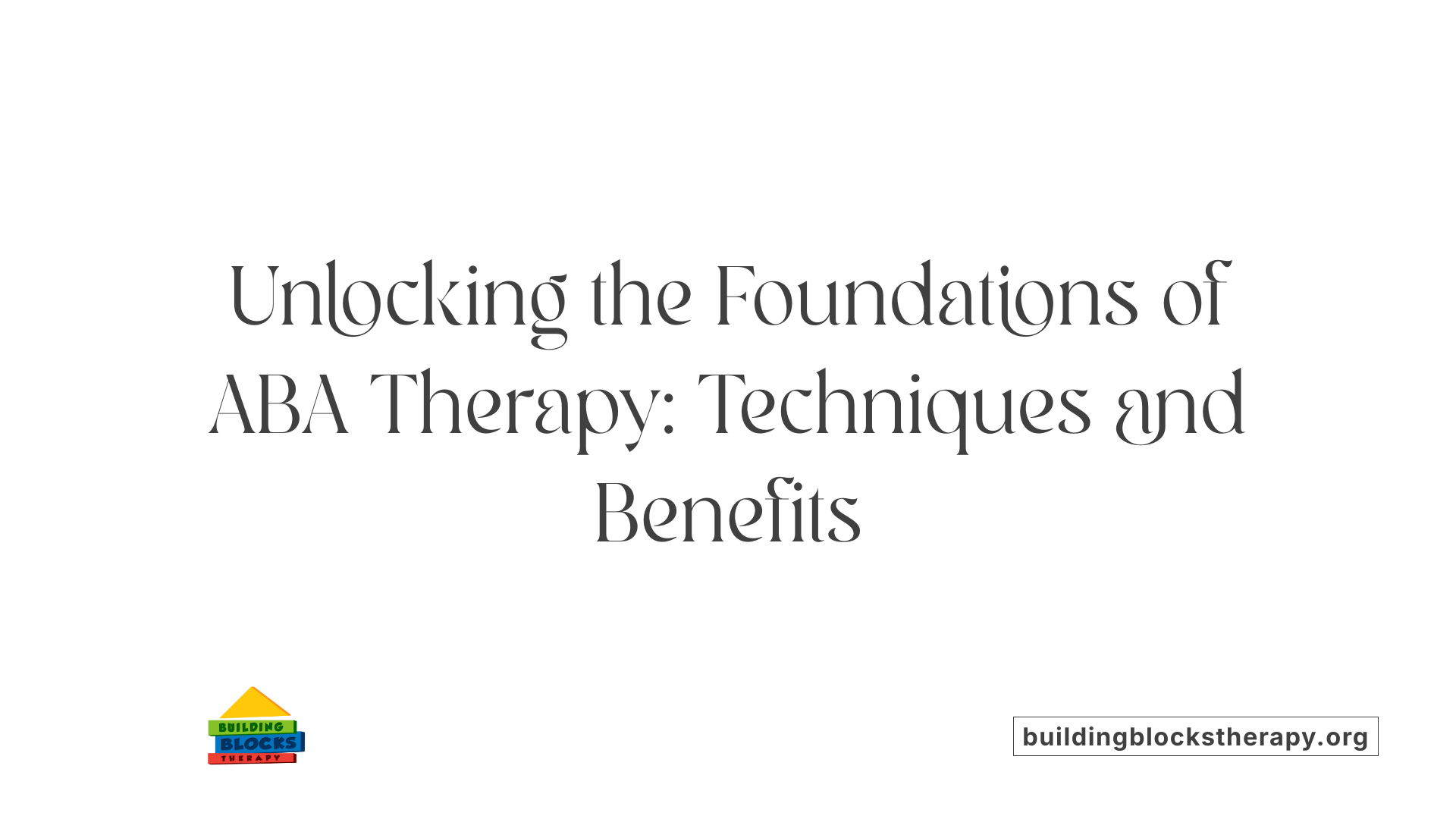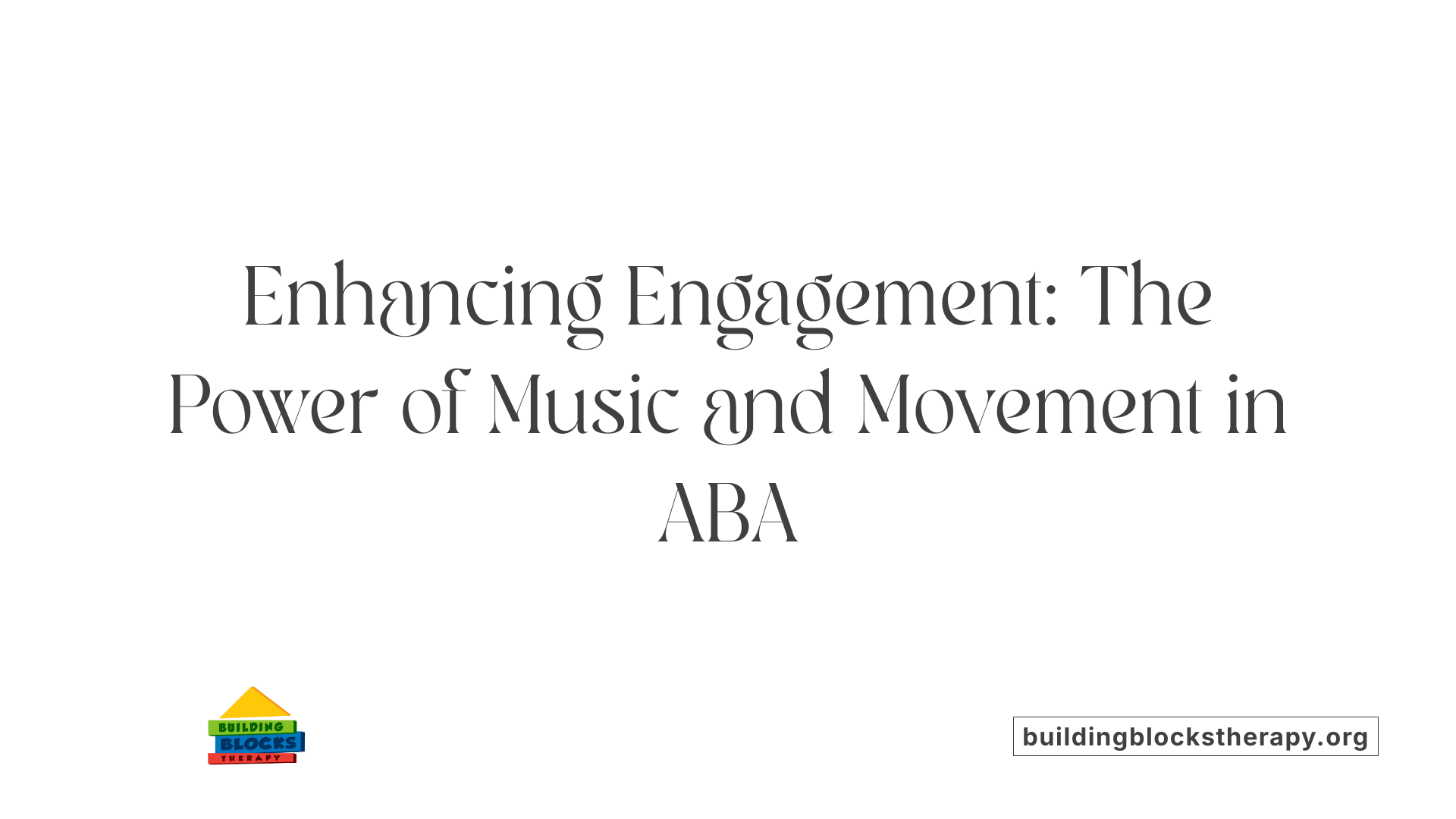The Role of Music and Movement in ABA Therapy for Autism
Harmonizing Healing: Integrating Music and Movement into ABA Therapy for Autism

Exploring the Synergy Between ABA Therapy and Music-Movement Interventions
Applied Behavior Analysis (ABA) therapy stands as a cornerstone in autism intervention, renowned for its evidence-based strategies in fostering communication, social skills, and adaptive behaviors. Recently, music and movement have emerged as transformative tools within ABA programs, enhancing engagement and accelerating skill acquisition. This article delves into the multifaceted role of music and movement in ABA therapy, examining how these elements enrich therapeutic outcomes for children with autism.
Understanding ABA Therapy and Its Core Principles

What is Applied Behavior Analysis (ABA) therapy and how does it help individuals with autism?
Applied Behavior Analysis (ABA) therapy is a scientifically proven approach that focuses on improving specific behaviors by understanding the relationship between behaviors and their environments. It helps individuals with autism develop critical skills such as communication, social interaction, and daily living activities.
ABA works by analyzing what happens before and after a behavior to teach or reinforce positive actions. Therapy sessions are tailored to the individual’s needs, often designed by certified professionals, and can be conducted across settings like home, school, and community. Caregivers are usually involved to help carry over the learned skills beyond therapy sessions. Research shows ABA is effective in enhancing language abilities, social skills, academic performance, and reducing challenging behaviors, especially with consistent, long-term intervention.
What are the main techniques used in ABA therapy?
ABA therapy employs a variety of structured techniques to encourage skill development and behavior change:
- Positive Reinforcement: Rewarding desired behaviors to increase their frequency.
- Discrete Trial Training (DTT): Breaking down skills into small, teachable units with repeated practice.
- Natural Environment Teaching (NET): Using everyday settings and interests to promote learning.
- Prompting and Fading: Providing and then gradually removing assistance to build independence.
- Behavior Chaining: Teaching complex tasks by linking simpler steps.
- Additional methods such as modeling, redirection, extinction, script fading, and functional communication training further support learning and behavior modification.
These strategies ensure that teaching is systematic, personalized, and focused on meaningful outcomes, helping individuals with autism gain functional skills for better everyday life.
Qualified Professionals Behind ABA Therapy

Who typically provides ABA therapy and what qualifications do they need?
ABA therapy is typically delivered by a team of qualified professionals including board-certified behavior analysts (BCBAs), therapists, and trained technicians. BCBAs hold advanced degrees and specialized certification in behavior analysis, ensuring they have the expertise to design and supervise effective therapy plans tailored to each child's needs.
Therapists and behavior technicians supporting the therapy process often complete focused training programs such as the Registered Behavior Technician (RBT) credential, which equips them with hands-on skills to implement ABA strategies.
Qualifications and certifications
Proper certification guarantees that providers meet professional and ethical standards. BCBAs, for instance, pass rigorous exams and must fulfill ongoing education requirements to maintain their credentials. Therapists and technicians also engage in continuous training, ensuring the latest, evidence-based ABA practices are applied.
Role of family involvement
Family participation is a cornerstone of successful ABA therapy. Qualified professionals work closely with parents and caregivers, educating them about therapy goals and techniques. This collaboration allows for consistent reinforcement of learned skills beyond therapy sessions, which promotes generalization and lasting improvement.
Ongoing data collection by the therapy team tracks progress, enabling adjustments to treatment plans tailored to individual responses. Access to these skilled providers may be supported through insurance, Medicaid, or scholarships, especially for families managing autism spectrum disorder (ASD). Selecting experienced and trained professionals who foster a family-centered approach helps maximize therapeutic outcomes for children.
Initiating ABA Therapy: The Assessment and Planning Process

What is the typical process for starting ABA therapy for a child with autism?
The process of beginning ABA therapy usually starts with a thorough initial assessment. A qualified professional, often a Board Certified Behavior Analyst (BCBA), conducts this detailed evaluation. It involves observing the child in play-based settings and assessing developmental milestones, language abilities, and autism-related behaviors. Input from parents and caregivers is invaluable during this stage to provide a complete understanding of the child’s needs.
Following the assessment, a personalized treatment plan is created. This plan is tailored to the child's specific strengths and challenges, targeting skill development areas such as communication, social interaction, and daily living skills. The plan incorporates evidence-based strategies like positive reinforcement and the ABC (Antecedent-Behavior-Consequence) model to guide interventions.
Continuous monitoring is essential throughout therapy. The BCBA oversees progress, making adjustments to treatment methods as needed to enhance effectiveness. Therapists and Registered Behavior Technicians (RBTs) implement daily sessions aligned with the treatment goals. Family involvement is encouraged, ensuring consistency and support across all environments, which helps reinforce the gains made during therapy.
Incorporating Music and Movement into ABA Therapy: Engagement and Learning

How music enhances engagement and attention
Music plays a vital role in ABA therapy by boosting children’s engagement during sessions. The use of music helps children focus better, making it easier for them to participate actively. Its rhythmic and repetitive nature captures attention, which is essential for children who might struggle with traditional therapy approaches. Moreover, music creates a calming environment that reduces anxiety, helping children feel more comfortable and ready to learn.
Use of songs to reinforce skill retention
Songs are strategically used to pair therapeutic skills with catchy melodies, which makes remembering and applying these skills more manageable. By embedding routines or vocabulary into music, children can recall and generalize what they've learned across different settings. This approach transforms abstract concepts into concrete, memorable experiences, enhancing long-term retention of skills.
Musical activities practicing communication and motor skills
Musical activities offer diverse opportunities for practicing communication, such as making verbal requests, turn-taking, and understanding social cues. These activities also support motor skill development through actions like dancing or playing instruments, which improve coordination, muscle strength, and body control. Additionally, integrating music with movement stimulates cognitive functions, including memory and attention, further supporting overall developmental progress in children undergoing ABA therapy.
Therapeutic Benefits of Music and Movement in Emotional and Social Development

How Does Music Help Reduce Anxiety and Regulate Emotions?
Music plays a vital role in creating a calming environment during ABA therapy. Therapeutic music sessions help children with autism safely process emotions, which aids in emotion regulation, stress reduction, and managing sensory overload. The soothing qualities of rhythmic melodies and structured musical activities provide a secure space for sensory exploration and relaxation.
In What Ways Does Music Promote Social Interaction and Turn-Taking?
Music and movement therapy encourage active group participation, helping children develop essential social skills like turn-taking and recognizing nonverbal cues. Activities such as singing, dancing, and instrument playing create opportunities for children to engage with peers and therapists, strengthening social connection and communication skills.
How Does Music Support Self-Expression and Identity?
Engaging in music and movement activities offers children a creative outlet for self-expression, fostering self-confidence and a sense of identity. This process is instrumental for social and emotional growth, as it empowers children to express feelings and thoughts in a nonverbal way that enhances their social interactions and emotional well-being.
Cognitive and Physical Advantages of Music and Movement Therapies
How do music and movement therapies enhance motor coordination and physical skills?
Music and movement activities such as dancing and playing instruments play a crucial role in improving motor coordination in children with autism. These activities help enhance muscle strength, flexibility, and overall body control. Engaging in rhythmic movements promotes better balance and physical agility, which supports daily functioning and independence.
In what ways do these therapies stimulate brain functions such as memory and attention?
Rhythmic activities in music therapy stimulate various brain functions, including memory, problem-solving, and attention span. The repetition and pattern recognition inherent in musical exercises aid cognitive development and help children generalize skills across different settings. This stimulation supports auditory processing and improves the child’s ability to focus during therapy and other daily tasks.
How is sensory integration improved, and how do music and movement reduce repetitive behaviors?
Music and movement therapy enhance sensory integration by engaging multiple senses—auditory, tactile, and proprioceptive—simultaneously. This multisensory approach helps children with sensory processing difficulties regulate their experiences and responses. Structured musical activities can reduce repetitive behaviors while increasing adaptive behaviors. Benefits also include improved focus, lowered aggression, and greater participation in social and academic environments.
Together, these cognitive and physical advantages showcase how music and movement therapies offer a comprehensive approach to support development in children with autism.
Supporting the Therapy Journey: Parental Roles and Therapy Duration
How can parents be involved through music at home to support ABA therapy?
Parents play a vital role in reinforcing ABA therapy goals by integrating music into daily life. Using a child's favorite songs as positive reinforcers encourages participation and motivation during tasks. Creating personalized playlists aligned with therapy objectives can make practicing skills more enjoyable and engaging outside sessions. Modeling musical participation—singing, dancing, or playing instruments—at home helps children generalize communication and social skills learned in therapy. This consistent musical interaction strengthens emotional bonds and extends therapeutic benefits beyond clinical settings.
How long does ABA therapy usually last and what factors influence its duration?
The length of ABA therapy varies widely, typically lasting anywhere from 3 to 5 years, tailored to each child's needs and progress. Longer durations generally correspond to better development, especially in language, cognition, and academics. Treatment intensity also affects outcomes; children with more significant challenges often benefit from 20 or more hours weekly. Factors influencing length include the severity of symptoms, age when therapy begins, initial skill levels, family involvement, and ongoing progress. Therapists regularly assess goal achievement to determine when tapering or concluding therapy is appropriate.
What outcomes can families expect from ABA therapy?
Families can anticipate improvements in their child's communication, social skills, and behavior management, which enhance daily functioning and interactions. Gains often include advances in language development, self-care, and adaptive behaviors, promoting greater independence. Programs that start early, are intensive, and tailor to the child's unique needs usually yield more significant progress. While individual results vary, many children demonstrate meaningful achievements that positively impact quality of life. Continued research aims to better understand the long-term effects and family experiences with ABA therapy.
Music and Movement: Vital Complement to ABA Therapy
Integrating music and movement within ABA therapy enriches traditional behavioral approaches by enhancing engagement, emotional regulation, and skill generalization for children with autism. This synergy supports communication, social development, cognitive and motor skills, while providing a creative and sensory-friendly environment. As research continues to affirm their value, these interventions offer families and practitioners dynamic, holistic tools that complement personalized ABA strategies. Ultimately, music and movement weave a harmonious layer into the fabric of autism therapy, fostering growth, confidence, and connection.
References
- Music in ABA Therapy: Enhancing Learning and Growth
- Ten Benefits of Music and Movement Therapy for Children ...
- Who Qualifies for ABA Therapy: Eligibility Guide
- An evaluation of the effects of intensity and duration on ...
- How Long Does ABA Therapy Last? | ABA for Autism
- Understanding ABA Therapy Duration & Progress
- ABA Techniques: Strategies for Behavior Analysts - GSEP Blog
- ABA Therapy Examples, Definition & Techniques






